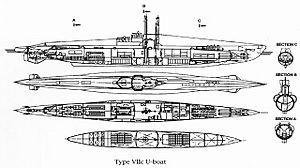German submarine U-245 facts for kids

A cross-section of a Type VIIC U-boat.
|
|
Quick facts for kids History |
|
|---|---|
| Name | U-245 |
| Ordered | 10 April 1941 |
| Builder | Germaniawerft, Kiel |
| Yard number | 679 |
| Laid down | 18 November 1942 |
| Launched | 25 November 1943 |
| Commissioned | 18 December 1943 |
| Fate |
|
| General characteristics | |
| Class and type | Type VIIC submarine |
| Displacement |
|
| Length |
|
| Beam |
|
| Height | 9.60 m (31 ft 6 in) |
| Draught | 4.74 m (15 ft 7 in) |
| Installed power |
|
| Propulsion |
|
| Speed |
|
| Range | |
| Test depth |
|
| Complement | 4 officers, 40–56 enlisted |
| Armament |
|
| Service record | |
| Part of: |
|
| Commanders: |
|
| Operations: |
|
| Victories: | 3 merchant ships sunk (17,087 GRT) |
The German submarine U-245 was a special kind of U-boat used by Nazi Germany during World War II. It was a Type VIIC submarine, which was a very common type of German submarine during the war.
U-245 was built in Kiel, Germany. Its construction started on 18 November 1942, and it was ready for action on 18 December 1943. Its commander was Friederich Schumann-Hindenberg. This U-boat went on three missions, called patrols, and managed to sink three enemy ships.
At the end of the war, U-245 gave up to the Allies on 9 May 1945. Later that year, on 7 December 1945, it was sunk on purpose as part of something called Operation Deadlight. This operation involved sinking many German U-boats so they couldn't be used again.
Contents
How U-245 Was Built
U-245 was a Type VIIC U-boat. These submarines were known for being strong and useful during the war. They were a bit longer than earlier models.
- Size: When on the surface, U-245 weighed about 769 tonnes (like 769 small cars!). When it went underwater, it weighed a bit more, around 871 tonnes. It was about 67 meters (220 feet) long, which is roughly the length of two tennis courts.
- Engines: To move on the surface, it used two powerful diesel engines. When it needed to dive and move underwater, it switched to two electric motors.
- Speed: On the surface, it could travel quite fast, up to 17.7 knots (about 33 kilometers per hour or 20 miles per hour). Underwater, it was slower, moving at about 7.6 knots (14 kilometers per hour or 9 miles per hour).
- Depth: This submarine could go very deep, safely diving to about 230 meters (755 feet). That's deeper than many tall buildings!
- Crew: A U-boat like U-245 needed a crew of about 44 to 60 people to operate it.
Weapons of the U-boat
U-245 was armed to attack enemy ships.
- Torpedoes: It had five torpedo tubes. Four were at the front (bow) and one was at the back (stern). It carried 14 torpedoes, which are like underwater missiles.
- Guns: It also had a large deck gun (an 8.8 cm naval gun) for attacking ships on the surface. For defending against airplanes, it had anti-aircraft guns, including a 3.7 cm Flak M42 gun and two smaller 2 cm anti-aircraft guns.
U-245 in Action
After its training, U-245 joined the main fighting forces. It was part of different groups of U-boats, called flotillas, during the war.
First Mission
U-245's first big mission started on 14 August 1944 from a base in Norway. It sailed into the Atlantic Ocean. During this patrol, on 30 September, an enemy Catalina flying boat attacked it. Luckily, the U-boat was not damaged, and no one was hurt.
Second Mission
On 5 February 1945, U-245 found and sank a ship named Henry B. Plant. This happened near Ramsgate, a town in England.
Third Mission
U-245's last mission was in April 1945. On 18 April, it sank two more ships: Filleigh and Karmt. Both of these ships were sunk near North Foreland in Kent, England.
The war was ending, and U-245 surrendered to the Allies in Norway on 9 May 1945. It was then taken to Loch Ryan in Scotland. As mentioned earlier, it was sunk on 7 December 1945 as part of Operation Deadlight, making sure it could never be used in battle again.

